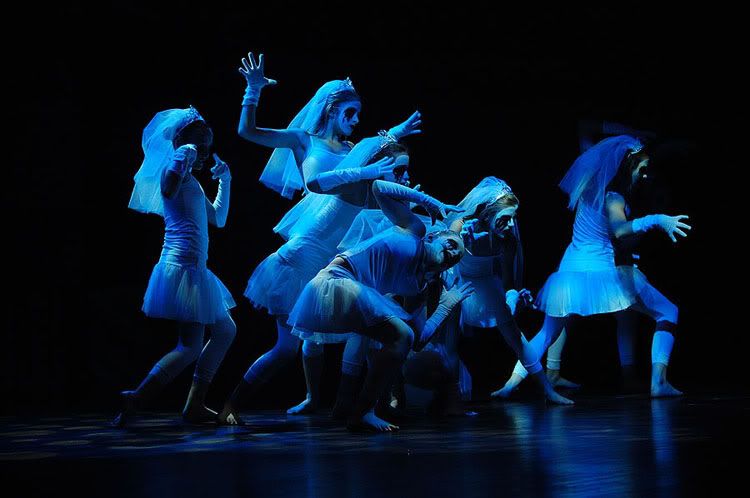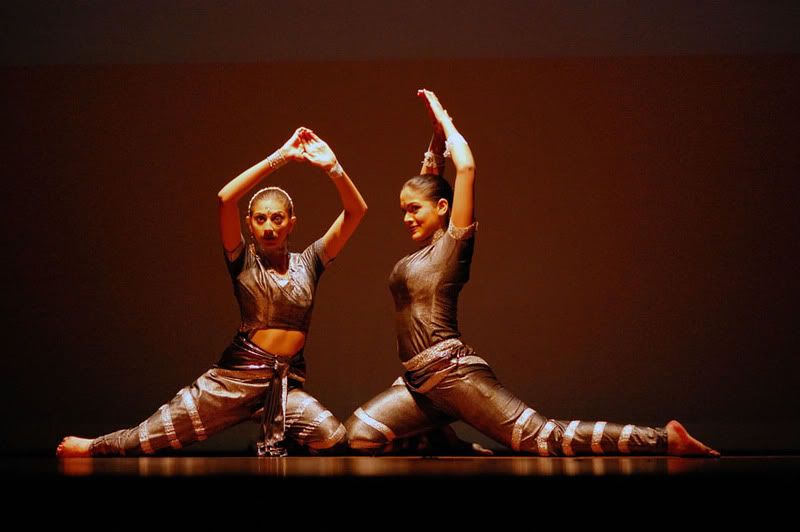 . D90 , 17-50 Tamron F2.8 matrix -2 EV .
. D90 , 17-50 Tamron F2.8 matrix -2 EV .The type of dances I have photographed in the past have involved rapidly changing lighting . Now if you are very proficient at manual then by all means shoot manual !
But I can't shoot manual like I drive a car yet [ perhaps that's fortunate ! ] .
So I decided to share my experience with dance photography and my 'safe' settings .
Firstly I shoot in matrix metering most of the time - it overexposes in these 'dark' conditions [ see " 3D matrix metering " ] but it is consistent with its over-exposure and generally one exposure compensation adjustment covers all scenes .
With red lighting you will need about "-3" because something about red lighting really confuses the metering system . With all other lighting I have found that matrix-2 EV compensation gives me a 99% keeper rate .
There's not much point in me shooting manual when the lighting changes so rapidly - I would miss too many shots trying to adjust for the lighting as it slowly , then quickly , changes .
I set my camera to 'S' " shutter priority [ 'Tv' time-value for canons ] at 1/125th sec and leave it to adjust iso and aperture to suit the conditions . At these settings I generally have enough speed to catch the motion , the aperture opens to its widest [ F2.8 with my 70-200 VR ] and then adjusts iso accordingly . If it gets to the stage where it is at iso 200 and there is enough light it will then start closing the aperture down - it always adjust for the lowest iso first then adjusts aperture afterwards .
This way , when the lighting gets really dim , I never have motion blur so that when it is at 1/125th , F2.8 and iso 3200 and the lighting goes too dark for the correct exposure it can't go any further and the picture looks a bit darker - but if it has reached those settings then the picture is supposed to look dark anyway and it looks right generally ! Like this .....

The iso was at its highest [ 1600 for the D40 ] , the shutter speed was at 1/125th where I set it and the aperture was at its widest [ F2.8 with the 70-200 ] . I was in centre weighted mode since the longer reach of the 70-200 means I can generally fill the frame with the subject but the point is that the camera still complained that it was way under-exposed and would have used a higher iso if possible - meanwhile the picture looked as I wanted !
It also means I don't have to wait for a 2 second exposure to finish if I was using aperture priority instead .
If you can do it shooting manual then go for it but when things are moving quickly sometimes it is good to know what a 'safe' automatic setting is .
With the Nikon D90 I can now set the display to show me the iso in the viewfinder so when someone really starts running and jumping around on the stage I can increase the shutter speed and watch the iso at the same time so I know what speed I can go up to for reasonable results . Low light photography is all about compromises , sometimes it is just better to get the shot at 1/250th and iso 3200 than have a blurred picture at 1/60th and iso 800 while trying to avoid noise .

With regard to processing all I have done with these shots is a levels adjustment -I simply move the left slider control [ which controls the dark areas ] toward the right and it makes the black areas properly black and kills the noise in those areas .
Occasionally the lighting will get good enough for the iso to drop to 200 ...
I also have a lens on each body - I don't like changing lenses ! The D50 does a pretty good job as well ......
Just a warning with regard to red lighting . The metering system battles with red lighting though it doesn't seem to mind a red background like this ....
 .... it does tend to over-expose reds when the actual lighting on the subject is red . Something about the metering causes more over-exposure with red lighting so you will need to dial in at least "-3" EV if you are using the matrix metering settings I have mentioned in these conditions .
.... it does tend to over-expose reds when the actual lighting on the subject is red . Something about the metering causes more over-exposure with red lighting so you will need to dial in at least "-3" EV if you are using the matrix metering settings I have mentioned in these conditions . As you can see the reds are still over-exposed at matrix-2 in the above picture - a lesson I learned at the last dance shoot ...
As you can see the reds are still over-exposed at matrix-2 in the above picture - a lesson I learned at the last dance shoot ....
Learn you use your head !



